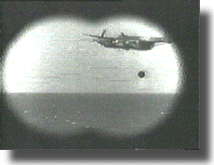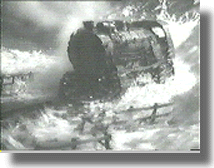 |
Dam Busters: clips from the movie
Who were the Dam Busters?
|
During World War II (1943), British scientist Barnes Wallis invented the
spinning cylindrical bomb -- a bomb in a barrel -- to blow up German
dams. The German dams provided hydroelectric power, water supply, a control
of canal levels; thus a blow to the dams would be devastating to the Germans.
A regular bomb would do no harm to the dams; the water would just cushion the
impact unless the bomb was right up next to the dam. Torpedos would not work
because the Germans had set up nets around the dam to prevent such an attack.
But if a bomb could be dropped from an airplane and then skip/bounce along the
water right up to the dam, it could work. So Wallis performed many
experiments to determine if it could work at all, the size of the bomb, and how
far from the dam it needed to be dropped. |
 |

|
|
He determined that the barrel bomb had to be dropped at a speed of 230 mph and
a height of 60 ft -- dangerously low. A special squadron of British pilots was
gathered by Wing Commander Guy P. Gibson to do the job, the 617 Squadron
(also called the Dam Busters and the Dam Raiders). Their targets were the
Mohne, Eder, and Sorpe Dams on the Ruhr in Germany. They successfully
breached the Mohne and Eder Dams, devastating Germany, but lost fifty-three
men in the process. |

|

|
 |
 |
|
clips from the movie Dambusters
courtesy of Canal & Image U.K. Ltd.
superimposed titles added by megann polaha |
More on the Dam Busters |
Spinning Clyindrical Bombs (Fluid Flow module)
National Aviation museum (#)
Columbiad (#) (a
great picture)
The Dambusters
Raid (#)
|
WarBirds (#)
Aviation Art (#)
A connection to the
movie The Wall (#)
About the book
Dambusters (#)
Sir Barnes
Wallis (#) (the inventor of the bomb)
| |
More recently, the Peruca dam in at-that-time Croatia was the subject of enemy
attack during the Patriotic War, 1991-5. Explosives were planted and exploded
in the grouting gallery and spillway with the intent to cause a catastrophic
flood destroying towns, villages, other dams, and hydroelectric plants. But
the dam held and disaster was averted. The ICOLD President, Dr. W. Pircher,
intervened, stressing the possible catastrophe if the dam failed. Reservoir
level was significantly lowered to avoid further consequences.
ref: Rupcic,
1997


|
|



